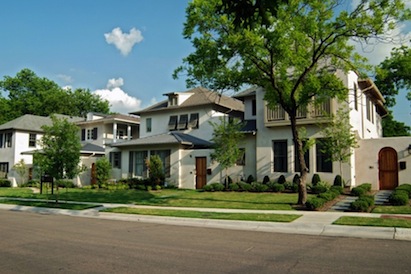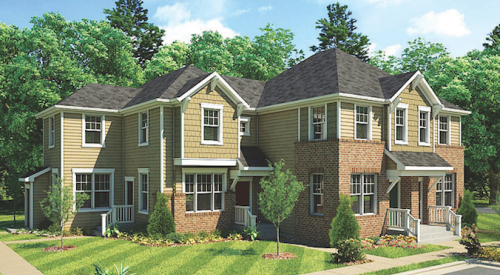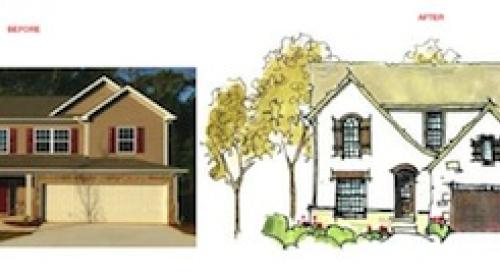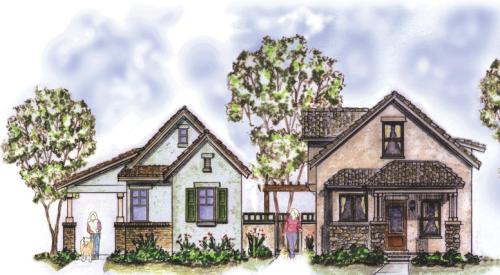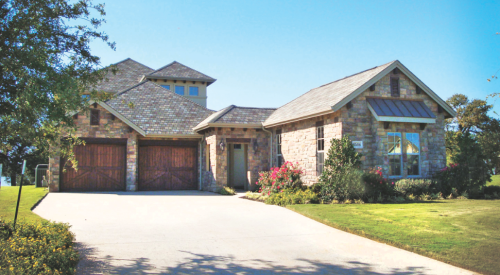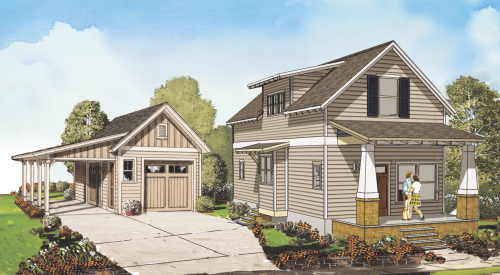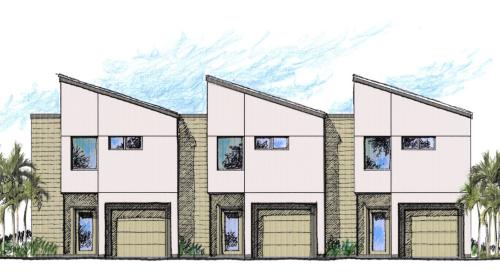Infill construction continues to provide opportunities in almost every community. While we typically consider most infill sites to be located in large urban areas, they can also be found in many small communities.
Parcels of land with existing utilities and in close proximity to public transportation are often overlooked because they present numerous challenges. Certainly, local restrictions and difficult lot sizes can prove quite formidable. However, exciting solutions for higher-density housing that maintain the appropriate architectural character, scale, and mass are usually welcomed by city leaders and neighbors.
The following designs and concepts offer a variety of projects with presentations that clearly communicate the value of well-conceived infill design.
For past House Review reports, visit www.HousingZone.com/HouseReview.
Edge

Architect
Anne Postle, AIA, CAASH
Osmosis Architecture
apostle@osmosisarchitecture.com
303.652.2668
www.osmosisarchitecture.com
Pland Size
First floor: 913 sf
Second floor: 960 sf
Optional third floor: 475 sf
Total with options: 2,348 sf
Width: 25 feet
Depth: 73 feet
The key to a successful narrow-lot infill project is a floor plan that blurs the edges between traditionally defined spaces and allows the plan to live large. The Edge project blurs the line between defined spaces, interior and exterior, and efficiency and flair. The 25-foot-wide floor plan lives large in both function and style.

A. Open living area blurs the edges between dining, living, and cooking spaces. These overlapping spaces allow the plan to live large.
B. The kitchen functions for both casual dining and party staging.
C. Outdoor and indoor living blend seamlessly.
D. The second floor blurs the line between efficiency and style. Every inch counts.
E. The optional third-floor loft provides ultimate flexibility.
South Florida Infill

Architect
Todd Hallett, AIA, CAPS
TK Design and Associates
thallett@tkhomedesign.com
248.446.1960
www.tkhomedesign.com
Plan Size
Living area: 2,275 sf
Porches: 58 sf
Width: 34 feet
Depth: 55 feet
Garage: 462 sf
Width: 21 feet
Depth: 22 feet
Infill housing can create some interesting challenges from a design standpoint. Infill lots are typically narrow or odd shaped, calling for thorough design analysis. Another consideration is the cost of construction. It’s easy to overshoot a neighborhood, so it is absolutely paramount to carefully study the surroundings for its existing and future potential. Finally, the design should be sensitive to the contextual fabric of the existing neighborhood. All of these factors play into the need for thoughtful planning in the design phase. The house portrayed here was designed to fit in an existing neighborhood in South Florida.

A. The flex room provides an area that can double as a formal dining room or convenient office off the kitchen.
B. The family entrance provides ample room for benches, cubbies, etc.
C. The extended two-story space and double arches team up to create more drama than the cast of “Real Housewives.”
D. The two-way stair from the kitchen is very popular. Access to the upper level from a hot spot is always a plus.
E. This home is designed for multi- generational living, with a full bedroom on the main living level.
F. The entrance is positioned to avoid creating a long hallway for this narrow design.
G. Two-story space opens up the entrance and makes the home feel much larger than it actually is.
[pagebreak]
Infill @ The Shopping Center

Architect
Richard C. Handlen, AIA, LEED AP
EDI International, Inc.
richard.handlen@edi-international.com
415.362.2880
www.edi-international.com
This infill project is on the perimeter of a large shopping center parking lot. The outer edges of the lot are typically empty, too far from the stores but adjacent to a mixed-use neighborhood. The addition of the proposed units takes advantage of the underutilized real estate, existing streets, and public transit with little impact on the parking for the shoppers. In some areas, the only impact on the existing parking configuration is the elimination of the outer stalls and reduced landscaping. To achieve this we used three-story wide/shallow units. The first level is devoted to the garage and entry. The second level houses a great room, and the bedrooms are located on the third level. The rows of units help to urbanize the public street while shielding the parking lot from view. The new residences help increase 24/7 activity at the shopping center.

A. Existing parking configuration
B. Existing landscape strip along a public street
C. Existing landscape strip against a neighboring property
D. Units with front doors facing the street and garages on the parking-lot side
E. The same floor plan at the side property lines with the front doors on the garage side.
Infill Remake
Architect
Donald F. Evans, AIA
The Evans Group
devans@theevansgroup.com
407.650.8770
www.theevansgroup.com
A national builder recently walked away from a mid-rise condominium community that has two 16-unit buildings unsold but completed, as well as unbuilt parcels of land. A local entrepreneur and attorney saw an opportunity to buy the remaining land and unsold condominium units. We analyzed the remaining site and determined that 32 single-family, higher-end homes would be best, and we designed the site plan utilizing most of the remaining roads, utilities, etc. We created a second gated entry to the homes and designed three home types: summit homes on the hill, park homes in the middle, and lake homes on the lake. Each home is three stories with elevators, lake views, pools, and all of the amenities today’s buyers are demanding.


A. Site plan
1. Existing units
2. Summit homes
3. Park homes
4. Lake homes
B. Streetscape elevation
C. Lake home floor plan – 3,629 square feet with three bedrooms, two full baths, and two half baths
D. While the cars are a short walk from each home, everyone travels through the landscaped courts, allowing interaction with neighbors.
[pagebreak]
4th Street Place

Architect
Rick Garza
RPGA Design Group, Inc.
rickgarza@rpgaarchitects.com
817.332.9477x206
www.rpgaarchitects.com
Plan Size
First floor: 1,741 sf
Second floor: 1,383 sf
Total: 3,124 sf
Mechanical: 76 sf
Garage: 518 sf
Porch: 83 sf
The 4th Street Place project was designed for narrow lots in an established neighborhood. The lots are 35 feet wide with a zero lot line wall on one side. The homes are 25 feet wide and are entered through a courtyard entry door that leads to the main entry to the home. The homes feature Low Country architecture, with clean, simple lines but lots of character. They are spacious with a formal dining room, family room, kitchen, breakfast, master bedroom, two secondary bedrooms upstairs, along with a large flex room. The exterior incorporates deep overhangs with shutters for screening the hot sun.

A. Courtyard entry
B. Formal dining for entertaining
C. Great room with breakfast area
D. Master bedroom with sitting area
E. Game room or exercise room
F. Tankless water heater
Barnard Street Bungalows

Designer
Larry W. Garnett, FAIBD
254.897.3518
larrygarnett@larrygarnettdesigns.com
www.smartlivinghomedesigns.com
With approximately 90 feet of street frontage and 370 feet of depth, this site presented an opportunity to create a cluster of small homes gathered around a series of landscaped common areas. The four single-family homes range from 980 to 1200 square feet. Each has a large front porch that faces a common courtyard.
The compact footprint of the two triplexes provides a great deal of flexibility for site placement. Each efficiently designed unit offers an open-concept living/dining/kitchen area. With the entrances located on opposite sides of the building, a high level of privacy is maintained.
The shared parking areas allow easy access without dominating each home. The location of the cars provides a daily opportunity for the residents to walk through the landscaped courts toward their front doors and talk with neighbors.

A. Triplex — each one-bedroom studio has approximately 700 square feet
B. Single-family cottages range from 980 square feet for a two-bedroom unit to 1,200 square feet for a three-bedroom model.
C. Courtyard
